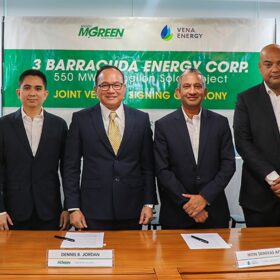ACWA Power secures $2.6 billion for 5.5 GW of solar in Saudi Arabia
ACWA Power has obtained $2.6 billion through a consortium of banks for three solar plants in Saudi Arabia, with a combined capacity of 5.5 GW.
Solar module installations could hit 592 GW in 2024
BloombergNEF says the global solar industry will install 592 MW of modules this year, up 33% on 2023. The consultancy has also lowered its estimate for 2024 polysilicon production, as manufacturers are temporarily scaling back output.
Vena Energy moves ahead with 550 MW of solar in the Philippines
Singapore’s Vena Energy and MGen Renewable Energy, the renewables unit of Manila-based Meralco PowerGen Corp., have signed an investment agreement for 550 MW of solar in the Philippines. Construction is due to start later this year.
PV systems can now support grid as fossil fuels decline, says IEA-PVPS
A new report by the International Energy Agency’s Photovoltaics Power Systems Programme (IEA-PVPS) says that existing PV systems have the technical capabilities to provide various frequency-related grid services.
Philippines fast-tracks world’s largest solar park with green lane certificate
The Board of Investments of the Philippines has granted a green lane certificate to a solar project that is being touted as the largest in the world to date. The accreditation will facilitate easier approval and processing of permits.
World’s highways could host 52.3 billion solar panels, say researchers
Researchers from the Chinese Academy of Sciences, Tsinghua University, Chinese Academy of Geosciences, and Columbia University have concluded that solar-covered highways could meet more than 60% of the world’s annual energy needs.
World’s largest vertical rooftop PV system deployed on Norway’s national football stadium
Norwegian vertical PV system provider Over Easy Solar deployed a 248.4 kW installation on Norway’s national football stadium. The system features over 1,200 vertical photovoltaic panels developed by Over Easy Solar itself.
Nigeria breaks ground on solar module assembling plant
Nigeria’s Minister for Innovation, Science and Technology has said the country is committed to replicating similar solar module assembling plants across all its geopolitical zones.
WoodMac says global solar tracker shipments grew by 28% in 2023
Global tracker shipments reached 92 GWdc last year, according to WoodMackenzies’ latest report. The US accounted for the majority of the global market, with three US-based manufacturers, Nextracker, Array Technologies and GameChange Solar, ranking as the three largest shippers in the world.
Ramaphosa reveals 22,500 MW renewables pipeline in South Africa
South African President Cyril Ramaphosa, in his first speech since forming a coalition government in May, said the nation is experiencing a “renewable energy revolution,” with upcoming projects expected to attract around ZAR 400 billion ($21.9 million) in private investment.















